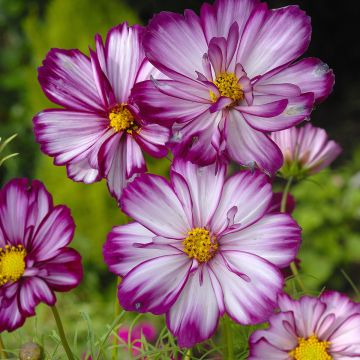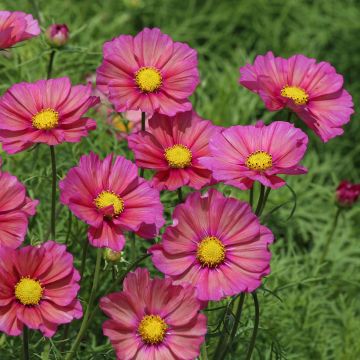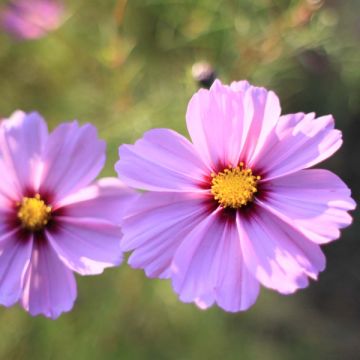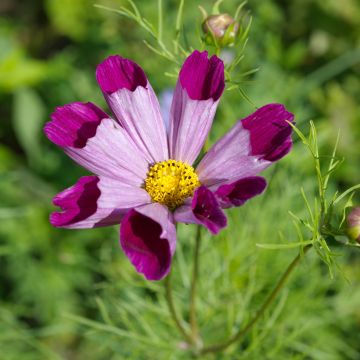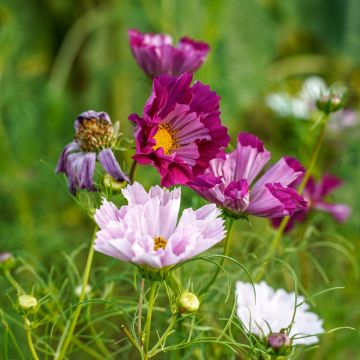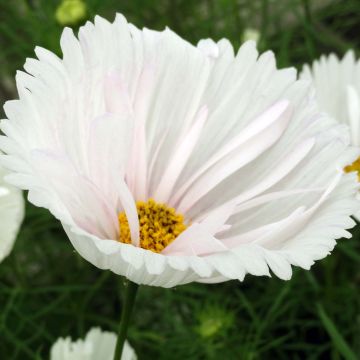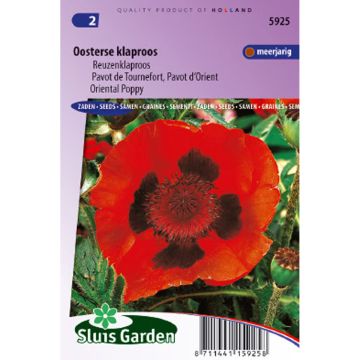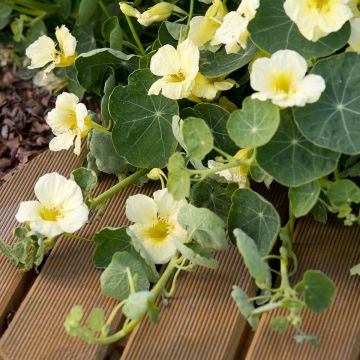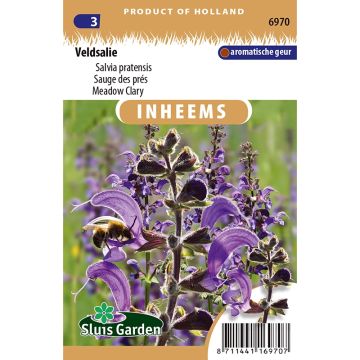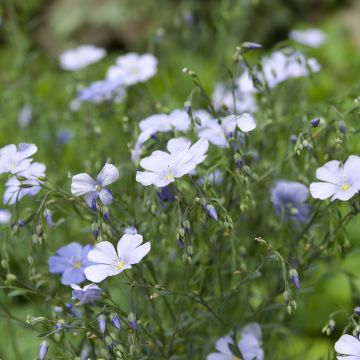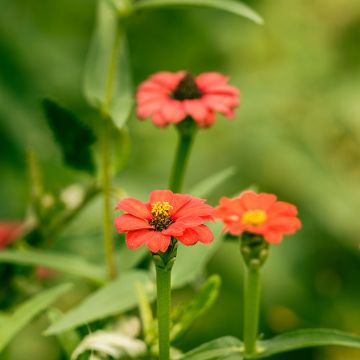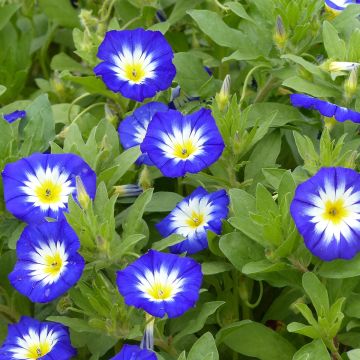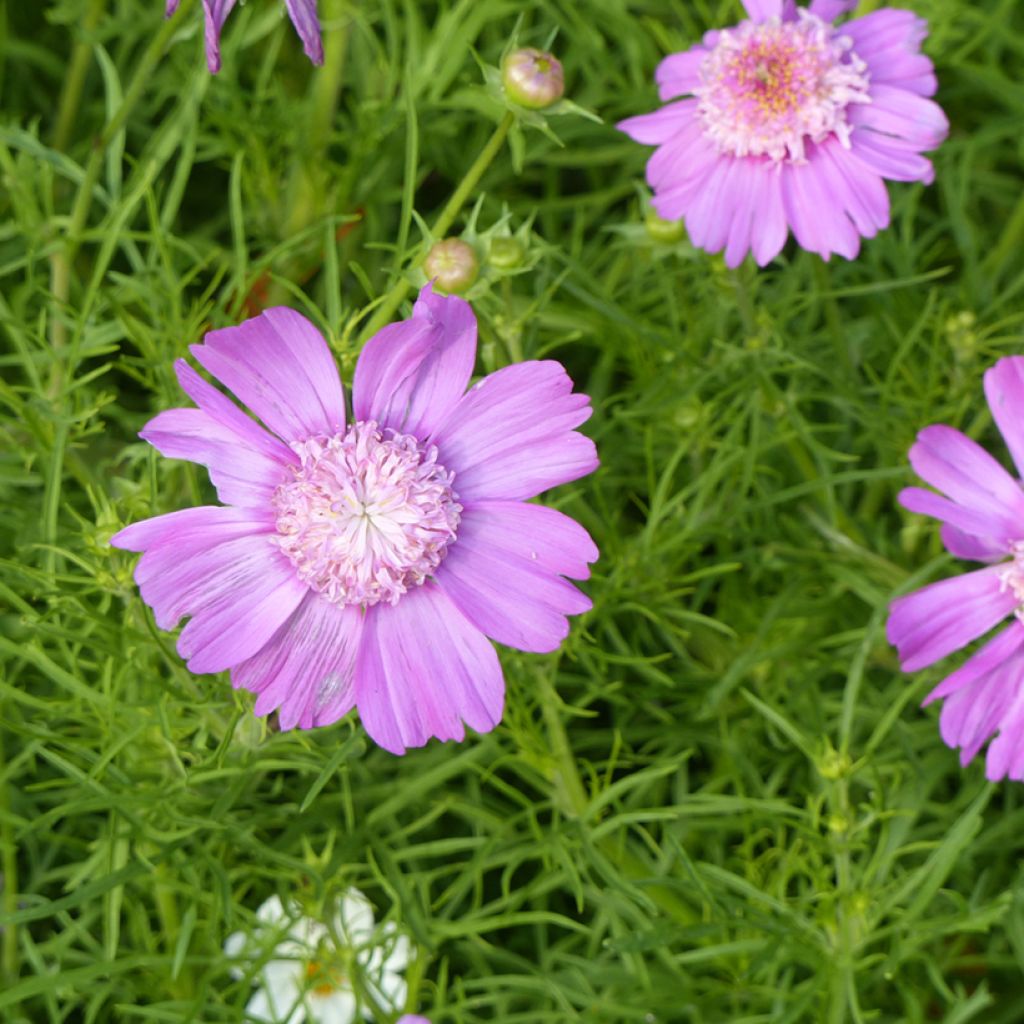

Cosmos Pink Popsocks seeds - Cosmos bipinnatus
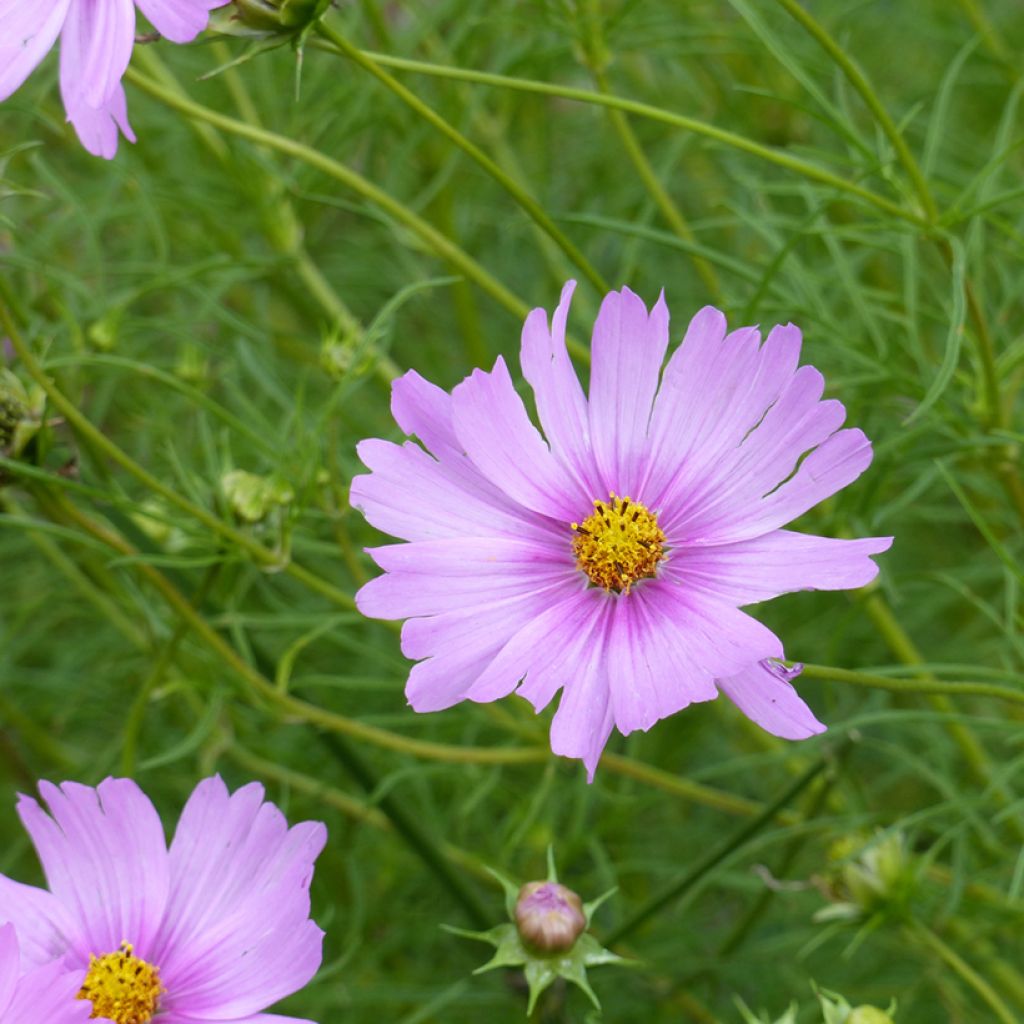

Cosmos Pink Popsocks seeds - Cosmos bipinnatus
Cosmos Pink Popsocks seeds - Cosmos bipinnatus
Cosmos x bipinnatus Pink Pop Socks
Garden Cosmos, Mexican Aster
Why not try an alternative variety in stock?
View all →This plant carries a 6 months recovery warranty
More information
We guarantee the quality of our plants for a full growing cycle, and will replace at our expense any plant that fails to recover under normal climatic and planting conditions.
From €5.90 for pickup delivery and €6.90 for home delivery
Express home delivery from €8.90.
Does this plant fit my garden?
Set up your Plantfit profile →
Description
Cosmos 'Pink Popsocks' is a variety of Cosmos bipinnatus or bipinnate Cosmos with delightful pink flowers of various shapes. This selection features single or anemone-like inflorescences similar to dahlias and double pompoms. They display various shades of pink-lilac to powdery pink. This charming variety is remarkable in borders, flower beds, and containers. Sow these very easy-to-grow cosmos in light, sunny soil.
Cosmos 'Pink Popsocks' is a cultivar derived from an annual species native to Mexico and the extreme southern United States, Cosmos bipinnatus. This half hardy annual plant, related to Dahlias, belongs to the Asteraceae family: it exhibits a characteristic flower head and particularly fine foliage reminiscent of fennel.
'Pink Popsocks' quickly forms a tuft 60 cm high, 45 cm wide. Flowering begins in July, approximately 85 days after sowing, and lasts until early autumn. The flower heads measure 8 cm in diameter. The flower centre consists of a golden disc. Cosmos flowers attract numerous insects and butterflies, including the Monarch. Left standing at the end of the season, their seeds serve as food for birds. The foliage is finely cut into thread-like segments, barely 0.5 to 1 mm wide, and is slightly and pleasantly scented. After flowering, the plant produces blackish achene fruits, spindle-shaped and bristly. The seeds can self-sow, but the resulting plants may not necessarily resemble their parent.
Capable of filling a sunny bank or bed on its own, Cosmos 'Pink Popsocks' is a carefree and rewarding annual plant, perfect for enhancing a romantic or country-style garden. Cosmos are perfect flowers for beginners, almost impossible to fail with. They grow quickly, adding a lot of lightness to the heavier blooms of Dahlias, and complement perennial salvias, Verbena Bonariensis, and chrysanthemums until the first frosts. Perfect for filling a brand new garden, mixed with poppies, love-in-a-mist, or annual cornflowers. Its flowers hold up very well in a vase.
Report an error about the product description
Flowering
Foliage
Plant habit
Botanical data
Cosmos
x bipinnatus
Pink Pop Socks
Asteraceae
Garden Cosmos, Mexican Aster
Cultivar or hybrid
Other Cosmos seeds
Planting and care
Sow Cosmos Pink Popsocks seeds from March to May, at a depth of 3mm, in a fine soil and cover the seeds with a very light sprinkling of vermiculite. Place the seed tray in a propagator at a temperature of 18-25°C or wrap it in a polythene bag. Keep the soil moist, but not waterlogged. Light promotes germination, which occurs 7 to 15 days after sowing.
When the seedlings are large enough to handle, transplant them into individual pots with a diameter of 7cm. Grow on in cooler conditions until the plants are sufficiently developed to be planted outside. Once all risk of frost has passed, gradually acclimatise the plants to outdoor conditions over 7 to 10 days. Plant them in full sun, in moist, well-drained soil, spaced 50cm apart. Pinch the tips of the shoots on each stem during transplantation to encourage branching of the stems and the production of numerous flowers.
Cosmos prefer a soil with a pH between 6 and 8.5, corresponding to the soil in their original habitat, the alkaline regions of Central America. They prefer full sun but can tolerate partial shade. These plants are drought-resistant once established, are not very prone to diseases, but can be a target for aphids. Spontaneous seedlings are common but not always true to type, without becoming invasive.
Sowing period
Intended location
This item has not been reviewed yet - be the first to leave a review about it.
Flower seeds
Haven't found what you were looking for?
Hardiness is the lowest winter temperature a plant can endure without suffering serious damage or even dying. However, hardiness is affected by location (a sheltered area, such as a patio), protection (winter cover) and soil type (hardiness is improved by well-drained soil).

Photo Sharing Terms & Conditions
In order to encourage gardeners to interact and share their experiences, Promesse de fleurs offers various media enabling content to be uploaded onto its Site - in particular via the ‘Photo sharing’ module.
The User agrees to refrain from:
- Posting any content that is illegal, prejudicial, insulting, racist, inciteful to hatred, revisionist, contrary to public decency, that infringes on privacy or on the privacy rights of third parties, in particular the publicity rights of persons and goods, intellectual property rights, or the right to privacy.
- Submitting content on behalf of a third party;
- Impersonate the identity of a third party and/or publish any personal information about a third party;
In general, the User undertakes to refrain from any unethical behaviour.
All Content (in particular text, comments, files, images, photos, videos, creative works, etc.), which may be subject to property or intellectual property rights, image or other private rights, shall remain the property of the User, subject to the limited rights granted by the terms of the licence granted by Promesse de fleurs as stated below. Users are at liberty to publish or not to publish such Content on the Site, notably via the ‘Photo Sharing’ facility, and accept that this Content shall be made public and freely accessible, notably on the Internet.
Users further acknowledge, undertake to have ,and guarantee that they hold all necessary rights and permissions to publish such material on the Site, in particular with regard to the legislation in force pertaining to any privacy, property, intellectual property, image, or contractual rights, or rights of any other nature. By publishing such Content on the Site, Users acknowledge accepting full liability as publishers of the Content within the meaning of the law, and grant Promesse de fleurs, free of charge, an inclusive, worldwide licence for the said Content for the entire duration of its publication, including all reproduction, representation, up/downloading, displaying, performing, transmission, and storage rights.
Users also grant permission for their name to be linked to the Content and accept that this link may not always be made available.
By engaging in posting material, Users consent to their Content becoming automatically accessible on the Internet, in particular on other sites and/or blogs and/or web pages of the Promesse de fleurs site, including in particular social pages and the Promesse de fleurs catalogue.
Users may secure the removal of entrusted content free of charge by issuing a simple request via our contact form.
The flowering period indicated on our website applies to countries and regions located in USDA zone 8 (France, the United Kingdom, Ireland, the Netherlands, etc.)
It will vary according to where you live:
- In zones 9 to 10 (Italy, Spain, Greece, etc.), flowering will occur about 2 to 4 weeks earlier.
- In zones 6 to 7 (Germany, Poland, Slovenia, and lower mountainous regions), flowering will be delayed by 2 to 3 weeks.
- In zone 5 (Central Europe, Scandinavia), blooming will be delayed by 3 to 5 weeks.
In temperate climates, pruning of spring-flowering shrubs (forsythia, spireas, etc.) should be done just after flowering.
Pruning of summer-flowering shrubs (Indian Lilac, Perovskia, etc.) can be done in winter or spring.
In cold regions as well as with frost-sensitive plants, avoid pruning too early when severe frosts may still occur.
The planting period indicated on our website applies to countries and regions located in USDA zone 8 (France, United Kingdom, Ireland, Netherlands).
It will vary according to where you live:
- In Mediterranean zones (Marseille, Madrid, Milan, etc.), autumn and winter are the best planting periods.
- In continental zones (Strasbourg, Munich, Vienna, etc.), delay planting by 2 to 3 weeks in spring and bring it forward by 2 to 4 weeks in autumn.
- In mountainous regions (the Alps, Pyrenees, Carpathians, etc.), it is best to plant in late spring (May-June) or late summer (August-September).
The harvesting period indicated on our website applies to countries and regions in USDA zone 8 (France, England, Ireland, the Netherlands).
In colder areas (Scandinavia, Poland, Austria...) fruit and vegetable harvests are likely to be delayed by 3-4 weeks.
In warmer areas (Italy, Spain, Greece, etc.), harvesting will probably take place earlier, depending on weather conditions.
The sowing periods indicated on our website apply to countries and regions within USDA Zone 8 (France, UK, Ireland, Netherlands).
In colder areas (Scandinavia, Poland, Austria...), delay any outdoor sowing by 3-4 weeks, or sow under glass.
In warmer climes (Italy, Spain, Greece, etc.), bring outdoor sowing forward by a few weeks.

































